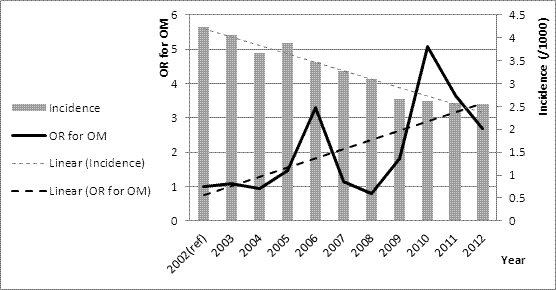Background: The study explored trends in acute myocardial infarction (AMI) hospitalizations and one-year all-cause post-discharge mortality (OM) considering changes in the risk profile (RP) of hospital survivors (HS).
Methods: a retrospective analysis of 11,108 consecutive AMI patients in a tertiary medical center in southern Negev (Israel) throughout 2002-2012. The annual incidence of AMI was calculated using a direct adjustment for age, sex and ethnicity. A multivariate prognostic model was built for each year in order to evaluate OM adjusted for a RP of the patients.
Results: A decrease in the adjusted incidence of AMI [4.2/1000 (2002) vs. 2.6/1000 (2012)]; and in-hospital mortality [9.1% (2002) vs. 6.4% (2012)] were observed (p-for-trend<0.001, each). However, OM among hospital survivors maintained at ~13% (p=0.4). An improvement in the RP (i.e. decrease of prevalence of most risk factors and increase of invasive treatments) of HS was found across the years; however the strength of the association of these factors with OM did not change. Adjustment of temporal changes in OM to changes in patients’ RP resulted in a significant increase throughout the years [AdjOR=1.12 per year (95% CI: 1.09-1.14), p<0.001].
Conclusions: throughout 2002-2012 significant improvement in the incidence, in-hospital mortality and RP of HS were found. However, OM increased considering the improved RP. Measures for improving prognosis of AMI HS of should be established.


